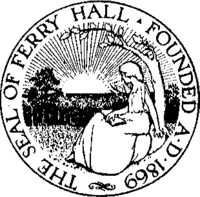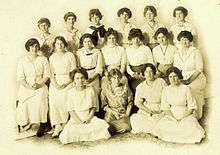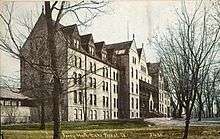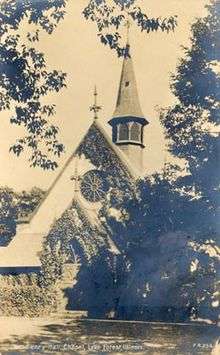Ferry Hall School
The Ferry Hall School was a girls' preparatory school founded in 1869 in Lake Forest, Illinois, United States. In 1974, Ferry Hall merged into Lake Forest Academy.

History

Originally named The Young Ladies' Seminary at Ferry Hall, the school was founded in 1869. The capital for the project was made possible by a bequest from the will of Rev. William Montague Ferry, a Presbyterian minister and missionary. In its first year of existence, Ferry Hall enrolled 66 students, 37 of whom boarded at the school. It immediately became known as a school for daughters of the Midwestern social elite, and was supported by such figures as Speaker of the House James G. Blaine and Illinois Lieutenant Governor William Bross. The first principal was Edward Payson Weston, a Congregationalist minister from Maine. Ferry Hall was "no mere finishing school";[1] rather, it provided something of liberal arts education for women, including uncommonly-taught subjects such as science and mathematics.[2] The Presbyterian influence on the school was very noticeable in the form of mandatory chapel, strict visitation rules (particularly for men), and rare opportunities to leave the campus.[3]

Over time, the Seminary became the "liberal alter-ego" of the town of Lake Forest, which "maintained staunchly conservative Republican Values."[4] The Seminary was well known for the support of social justice and missionary work, and became noticeable for inviting such figures as Eugene V. Debs, photographer Jacob Riis, and a man from the National Peace Conference to speak at the school. From 1904-1914, the Seminary was headed by Socialist Frances L. Hughes.

In 1918, Eloise Ruthven Tremain took over as the head of the Seminary, beginning a 27-year-long period "noted mostly for the principal's control."[5] Under Tremain's control, the Seminary entered a period of notable organization and financial success, continually running surpluses.[6] Tremain "quickly raised the esteem of Ferry Hall in the local community"[7] and brought Ferry Hall to the forefront of American schools for girls, garnering national attention. Tremain engineered the Seminary's legal and financial independence in 1925 from Lake Forest University, to which it had formerly been tied.[8] Hollywood film studios were aware of Ferry Hall's stature and used it in promoting the career of Jean Harlow, a former Ferry Hall student. The film industry made much of Harlow's superior education: "To be admitted to Ferry Hall was a social achievement; to graduate from the school was a scholastic accomplishment".[9] Ironically, Harlow never graduated.
Following Tremain's departure in 1947, the school slipped into financially hard times. Enrollment, which had been filled to capacity during the World War II, dropped off significantly; though some "suggested the school needed to reestablish its reputation through public relations and advertising," new headmistress Frances Wallace "stubbornly refused to try" these avenues.[10] Ferry Hall's trustees stepped in and organized a major capital campaign that was intended to retire the mortgage still owed to Lake Forest College, eventually succeeding in the early 1950s.

In the 1970s, headmaster John A. Bird began working with Lake Forest Academy to achieve coeducation: the schools had always been considered sister schools and, in recent years, had been offering opportunities to students of both schools. In the spring of 1974, the last class graduated from Ferry Hall. In the fall, Ferry Hall students joined Academy boys at their Mellody Farms campus and created the current coeducational institution Lake Forest Academy-Ferry Hall.
Notable alumnae
- Jean Harlow, model and actress.
- Frances Perkins, (Ferry Hall chemistry teacher 1904-06; did not attend as a student.) First female U.S. Cabinet member U.S. Secretary of Labor under U.S. President Franklin D. Roosevelt.
- Florence R. Sabin (Primary Department student 1879-1882.) Trailblazer for women in medical sciences.
- Marion Coats (Ferry Hall Principal 1915-1918; did not attend as a student.) First president of Sarah Lawrence College.
- Doris Emrick Lee (1920–22), artist.
- Winifred Bonfils (1878-1880), newspaper journalist.
- Charlotte Armstrong Lewi (1921–22), author/mystery writer.
- Judy Baar Topinka, Illinois State Treasurer.
- Amy Hempel, author.
Notes
- Pridmore 36
- Pridmore 36-37
- Pridmore 38-40
- Pridmore 96
- Pridmore 125
- Pridmore 121
- Pridmore 123
- Pridmore 124
- Shulman 58
- Pridmore 163
References
- Jay Pridmore; Megan C. McGuire '88, Martha Briggs (1994). Anne Gendler (ed.). Many Hearts and Many Hands: The History of Ferry Hall and Lake Forest Academy. William A. Seabright, John A. Scrapes, Dan Grayson, Alan Shortall. Brookfield, Wisconsin: Burton and Mayer. p. 264. ISBN 0-9643350-0-X.
- Irving Shulman (1964). Harlow: An Intimate Biography. Random House, New York, New York: Bernard Geis Associates. ISBN 978-0-916515-61-4.
External links
- Lake Forest Academy-Ferry Hall official website
- Ferry Hall School history from the Lake Forest Academy official site